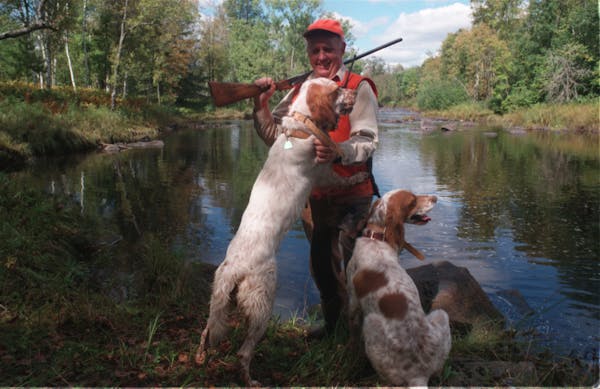Saturday morning, when archery deer hunting season begins anew, some Minnesotans who climb into tree stands will take the easy way out.
Just as the Legislature did in its last session.
Armed with crossbows, which until now have been illegal to use to seek deer in Minnesota unless a hunter is 60 or older or physically impaired, this new breed of archer will be looking to waylay a doe or buck not thanks to skill, practice or patience — long the hallmarks of someone who appreciates the difference between hunting and killing.
Required instead of crossbow users to hit their four-legged marks this fall will only be sufficient disposable income to drop about a grand for a misnamed killing machine that's more firearm than bow.
Given the comfort-seeking times in which we live, perhaps it was inevitable that crossbows, which some owners have used to kill deer at 130 yards and more, ultimately would achieve the same regulatory status as longbows, recurves and compound bows, whose ranges, typically, are 15 to 30 yards.
The tomfoolery used to justify the change asserts the nation's aging hunters need coddling.
To accommodate these softies, for example, Minnesota has established four September waterfowl "openers" before the Saturday nearest Oct. 1, the traditional date of the state's first day of duck hunting.
And why not?
It's chilly on October and November mornings, and the Department of Natural Resources (DNR) wants to ensure no one is dissuaded from waterfowl hunting by the prospect of cold fingers or numbed feet.
It should be just the opposite.
Some aspects of modern-day society — and hunting and fishing provide ideal forums — should be reserved for traditionalists who believe reward and effort should be in equilibrium, a particularly worthwhile notion when the taking of an animal's life is at stake.
Legalizing crossbows as Minnesota sporting tools earlier this year were legislators who skipped public hearings on the proposed change and instead sneaked the provision into a conference committee report.
For this you can thank Sen. Foung Hawj, DFL-St. Paul, and Rep. Rick Hansen, DFL-South St. Paul. The former offered the idea and the latter agreed.
The DNR didn't formulate a position on crossbows, because no hearing was held. The agency's boss for big game, Barb Keller, said this week her agency will monitor the increase in archery license sales that is sure to ensue, and also ask archers, real ones and the newfangled kind, which method they used to kill deer when they register their animals.
All good. But make no mistake. Not this year or next, but soon enough, Minnesota crossbow users will outnumber traditional archers, just as they do now in Wisconsin, which approved a similar change starting in 2014.
Unlike in Minnesota, where a standard archery license is all that's needed to pursue deer with a crossbow, in Wisconsin, anyone who wants to use a crossbow must purchase a specific license. In 2014, almost 48,000 did — a number that by 2022 grew to more than 122,000. Deer killed in Wisconsin by crossbow users rose proportionately and now outpaces those felled by traditional archers, about 64,000 to 38,000.
The size of the Wisconsin crossbow deer harvest gain might be unique because its firearms season is held after the buck rut, Keller said. Therefore, some Wisconsin firearms hunters might be opting for crossbows instead of firearms so they can hunt during the rut, which generally peaks about two weeks before Wisconsin's gun season opens.
Harvard professor Daniel Lieberman is one expert among many to assert that most people are inherently lazy. Which is why the crossbow boondoggle here will never be recanted, even though the DNR will develop an appraisal of its ramifications in three years.
By then, too many Minnesota deer seekers will have bought crossbows, and the natural constituency that already exists around these arrow ("bolt") slingers — including archery manufacturers and retailers and the DNR, whose business is selling licenses — will have only grown bigger and more vocal.
Some will argue that expanding legalization of crossbows is nothing more than another step in the progression from longbows to recurves to modern compound bows. But most off-the-shelf crossbows can, within a half-hour or so in the hands of a novice, shoot 3-inch groups at 50 yards, whereas the best hunting archers shooting the best compound bows are challenged to achieve that feat with a lifetime of practice.
Perhaps there's no surprise here.
After all, bass, walleye and muskie anglers increasingly deploy forward sonar imaging gadgets that identify the species, size and whereabouts of fish, which is easier than anglers using their knowledge, experience and grit for the same purpose.
So why not legalize crossbows to whack whitetails?
Two reasons: It's too easy, and their use promotes killing, not hunting.
Better, I say, to go, or stay, retro and consider archery less as a way to put meat in a freezer and more as a means of self-discovery.
As Eugen Herrigel, author of "Zen in the Art of Archery," has said: In the end, archery should be a contest of the archer with himself.

Anderson: Chiovitte's state record walleye shouldn't be thrown back

Anderson: Minnesota's muskies are no match for sonar gadget

Anderson: Anatomy of a nighttime helicopter rescue in Boundary Waters

Anderson: With summer training, know a dog's tail is meant to wag



